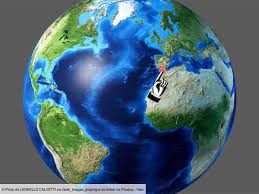In 20 million years, the Atlantic Ocean could begin to close, bringing Europe and the Americas closer together. A German-Portuguese team is monitoring the geological base of the Strait of Gibraltar, an area they believe could form a future “ring of fire” (Geology).
When scientists manage to reconstruct the movements of tectonic plates over several hundred million years, it gives rise to fascinating videos of supercontinents fragmenting, oceans emerging and continents coming together… like so many « dances », extremely slow, which a press on the « accelerate » button reveals.
If we could extend these timelapse sequences into the future, what “choreographies” would we witness? For the authors of a study published in the journal Geology (February 13, 2024), a significant episode of the “Wilson cycle” – describing how oceans form and then disappear on the Earth’s surface – should take place in a twenty million years.
Subduction zone
Born from the breakup of Pangea, an ancient supercontinent, 180 million years ago, the Atlantic Ocean could one day close again. These scientists from the universities of Lisbon (Portugal) and Johannes Gutenberg in Mainz (Germany) are now looking for warning signs at the geological base of the Strait of Gibraltar. But why in this specific place?
For Europe and the Americas to come closer together, one part of the oceanic crust would have to dive under another, at what is called a subduction zone. However, these researchers affirm that an old, not very active subduction zone located under the Strait of Gibraltar is in the process of migrating, by “subduction invasion”, from the Mediterranean to the Atlantic.
By moving west, this area should gain in geological activity, write the authors on the basis of computer modeling, to the point of becoming a future “ring of fire” – like the one that surrounds it today. today the Pacific Ocean and which concentrates a large part of the seismic events and volcanoes on Earth.
“Subduction invasion is by nature a three-dimensional process. This requires advanced modeling tools and supercomputers that were not available a few years ago,” said João Duarte, co-author of the paper and researcher at the Instituto Dom Luiz at the University of Lisbon, in a press release. “We can now simulate the formation of the Gibraltar arc in the smallest details, as well as its evolution in the distant future. »
“An invaluable opportunity”
However, the authors mention the existence of two other subduction zones in the Atlantic Ocean: the Lesser Antilles, in the Caribbean, and the Scotia Arc, near Antarctica. “However, these subduction zones invaded the Atlantic several million years ago. The study of Gibraltar is an invaluable opportunity because it allows us to observe the process at its beginnings, when it is happening,” believes the Portuguese researcher.
“The discovery that Gibraltar subduction is still active has important implications for seismic activity in the region,” emphasizes the Geological Society of America. “During this slow phase, recurrence intervals should be very long. But the risk of high-magnitude events, such as the Lisbon earthquake in 1755 [the most violent earthquake ever recorded by man – FranceArchives.gouv, Editor’s note], remains and requires preparation. »



